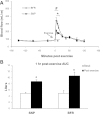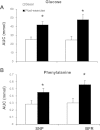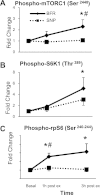Reactive hyperemia is not responsible for stimulating muscle protein synthesis following blood flow restriction exercise
- PMID: 22362401
- PMCID: PMC3362234
- DOI: 10.1152/japplphysiol.01267.2011
Reactive hyperemia is not responsible for stimulating muscle protein synthesis following blood flow restriction exercise
Abstract
Blood flow restriction (BFR) to contracting skeletal muscle during low-intensity resistance exercise training increases muscle strength and size in humans. However, the mechanism(s) underlying these effects are largely unknown. We have previously shown that mammalian target of rapamycin complex 1 (mTORC1) signaling and muscle protein synthesis (MPS) are stimulated following an acute bout of BFR exercise. The purpose of this study was to test the hypothesis that reactive hyperemia is the mechanism responsible for stimulating mTORC1 signaling and MPS following BFR exercise. Six young men (24 ± 2 yr) were used in a randomized crossover study consisting of two exercise trials: low-intensity resistance exercise with BFR (BFR trial) and low-intensity resistance exercise with sodium nitroprusside (SNP), a pharmacological vasodilator infusion into the femoral artery immediately after exercise to simulate the reactive hyperemia response after BFR exercise (SNP trial). Postexercise mixed-muscle fractional synthetic rate from the vastus lateralis increased by 49% in the BFR trial (P < 0.05) with no change in the SNP trial (P > 0.05). BFR exercise increased the phosphorylation of mTOR, S6 kinase 1, ribosomal protein S6, ERK1/2, and Mnk1-interacting kinase 1 (P < 0.05) with no changes in mTORC1 signaling in the SNP trial (P > 0.05). We conclude that reactive hyperemia is not a primary mechanism for BFR exercise-induced mTORC1 signaling and MPS. Further research is necessary to elucidate the cellular mechanism(s) responsible for the increase in mTOR signaling, MPS, and hypertrophy following acute and chronic BFR exercise.
Figures









Similar articles
-
Blood flow restriction exercise stimulates mTORC1 signaling and muscle protein synthesis in older men.J Appl Physiol (1985). 2010 May;108(5):1199-209. doi: 10.1152/japplphysiol.01266.2009. Epub 2010 Feb 11. J Appl Physiol (1985). 2010. PMID: 20150565 Free PMC article. Clinical Trial.
-
Activation of mTORC1 signaling and protein synthesis in human muscle following blood flow restriction exercise is inhibited by rapamycin.Am J Physiol Endocrinol Metab. 2014 May 15;306(10):E1198-204. doi: 10.1152/ajpendo.00600.2013. Epub 2014 Apr 1. Am J Physiol Endocrinol Metab. 2014. PMID: 24691032 Free PMC article. Clinical Trial.
-
Blood flow restriction during low-intensity resistance exercise increases S6K1 phosphorylation and muscle protein synthesis.J Appl Physiol (1985). 2007 Sep;103(3):903-10. doi: 10.1152/japplphysiol.00195.2007. Epub 2007 Jun 14. J Appl Physiol (1985). 2007. PMID: 17569770
-
Exercise, amino acids, and aging in the control of human muscle protein synthesis.Med Sci Sports Exerc. 2011 Dec;43(12):2249-58. doi: 10.1249/MSS.0b013e318223b037. Med Sci Sports Exerc. 2011. PMID: 21606874 Free PMC article. Review.
-
Mechanisms Behind Blood Flow-Restricted Training and its Effect Toward Muscle Growth.J Strength Cond Res. 2019 Jul;33 Suppl 1:S167-S179. doi: 10.1519/JSC.0000000000002384. J Strength Cond Res. 2019. PMID: 30011262 Review.
Cited by
-
Effectiveness of Blood Flow Restriction on Functionality, Quality of Life and Pain in Patients with Neuromusculoskeletal Pathologies: A Systematic Review.Int J Environ Res Public Health. 2023 Jan 12;20(2):1401. doi: 10.3390/ijerph20021401. Int J Environ Res Public Health. 2023. PMID: 36674158 Free PMC article.
-
Technical and Training Related Aspects of Resistance Training Using Blood Flow Restriction in Competitive Sport - A Review.J Hum Kinet. 2018 Dec 31;65:249-260. doi: 10.2478/hukin-2018-0101. eCollection 2018 Dec. J Hum Kinet. 2018. PMID: 30687436 Free PMC article.
-
Cycling with blood flow restriction improves performance and muscle K+ regulation and alters the effect of anti-oxidant infusion in humans.J Physiol. 2019 May;597(9):2421-2444. doi: 10.1113/JP277657. Epub 2019 Mar 28. J Physiol. 2019. PMID: 30843602 Free PMC article.
-
Hypoxia and resistance exercise: a comparison of localized and systemic methods.Sports Med. 2014 Aug;44(8):1037-54. doi: 10.1007/s40279-014-0177-7. Sports Med. 2014. PMID: 24715613 Review.
-
Blood flow-restricted resistance exercise: rapidly affecting the myofibre and the myonuclei.J Physiol. 2012 Nov 1;590(21):5271. doi: 10.1113/jphysiol.2012.242859. J Physiol. 2012. PMID: 23118067 Free PMC article. No abstract available.
References
-
- Abe T, Kearns CF, Sato Y. Muscle size and strength are increased following walk training with restricted venous blood flow from the leg muscle, Kaatsu-walk training. J Appl Physiol 100: 1460–1466, 2006 - PubMed
-
- Abe T, Sakamaki M, Fujita S, Ozaki H, Sugaya M, Sato Y, Nakajima T. Effects of low-intensity walk training with restricted leg blood flow on muscle strength and aerobic capacity in older adults. J Geriatr Phys Ther 33: 34–40, 2010 - PubMed
-
- Abe T, Sato Y, Inoue K, Midorikawa T, Yasuda T, Kearns CF, Koizumi K, Ishii N. Muscle size and IGF-1 increased after two weeks of low-intensity “Kaatsu” resistance training. Med Sci Sports Exerc 36: S353–S353, 2004
Publication types
MeSH terms
Substances
Grants and funding
LinkOut - more resources
Full Text Sources
Medical
Miscellaneous

